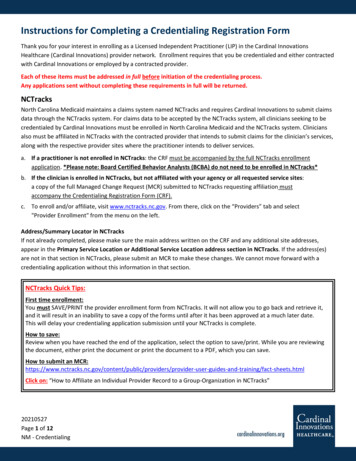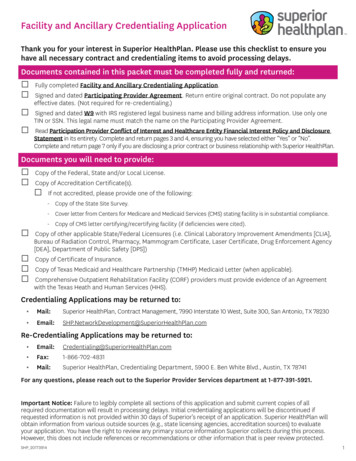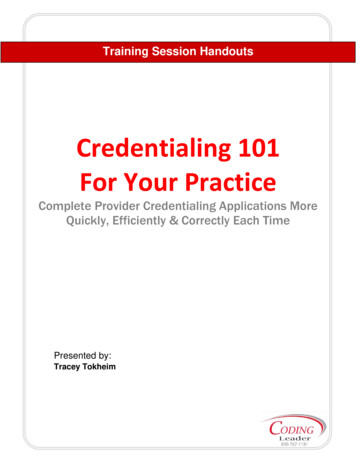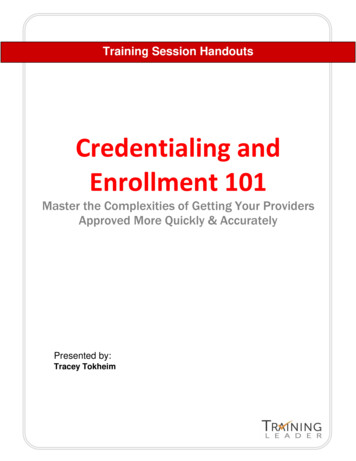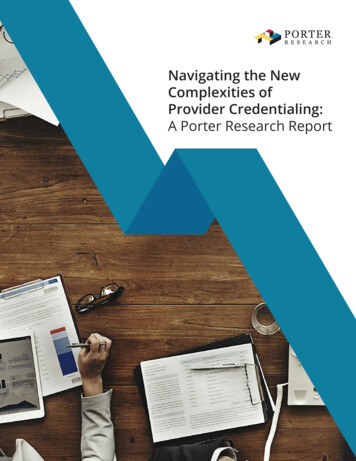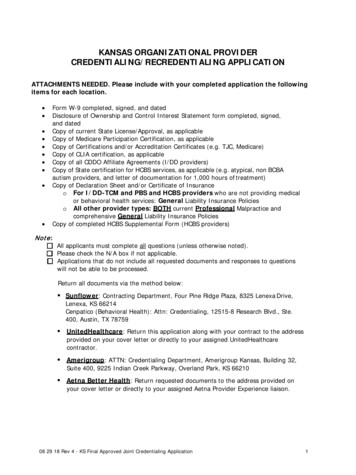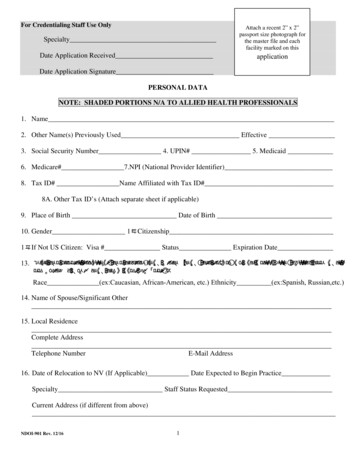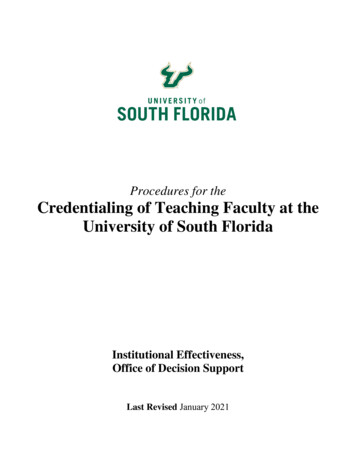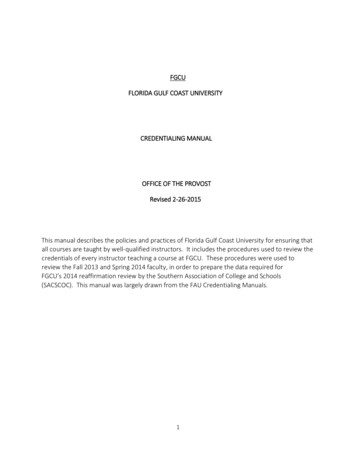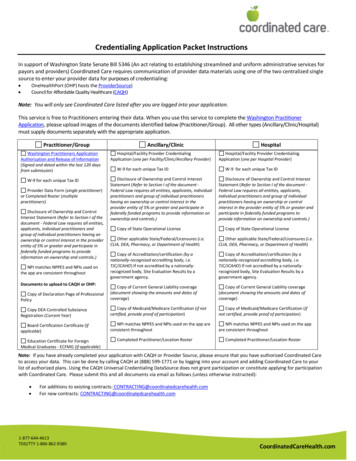
Transcription
Credentialing Application Packet InstructionsIn support of Washington State Senate Bill 5346 (An act relating to establishing streamlined and uniform administrative services forpayors and providers) Coordinated Care requires communication of provider data materials using one of the two centralized singlesource to enter your provider data for purposes of credentialing: OneHealthPort (OHP) hosts the ProviderSource)Council for Affordable Quality Healthcare (CAQH)Note: You will only see Coordinated Care listed after you are logged into your application.This service is free to Practitioners entering their data. When you use this service to complete the Washington PractitionerApplication, please upload images of the documents identified below (Practitioner/Group). All other types (Ancillary/Clinic/Hospital)must supply documents separately with the appropriate application.Practitioner/GroupWashington Practitioners ApplicationAuthorization and Release of Information(Signed and dated within the last 120 daysfrom submission)W-9 for each unique Tax IDProvider Data Form (single practitioner)or Completed Roster (multiplepractitioners)Disclosure of Ownership and ControlInterest Statement (Refer to Section I of thedocument - Federal Law requires all entities,applicants, individual practitioners andgroup of individual practitioners having anownership or control interest in the providerentity of 5% or greater and participate infederally funded programs to provideinformation on ownership and controls.)Ancillary/ClinicHospital/Facility Provider CredentialingApplication (one per Facility/Clinic/Ancillary Provider)W-9 for each unique Tax IDDisclosure of Ownership and Control InterestStatement (Refer to Section I of the document Federal Law requires all entities, applicants, individualpractitioners and group of individual practitionershaving an ownership or control interest in theprovider entity of 5% or greater and participate infederally funded programs to provide information onownership and controls.)Copy of State Operational LicenseHospitalHospital/Facility Provider CredentialingApplication (one per Hospital Provider)W-9 for each unique Tax IDDisclosure of Ownership and Control InterestStatement (Refer to Section I of the document Federal Law requires all entities, applicants,individual practitioners and group of individualpractitioners having an ownership or controlinterest in the provider entity of 5% or greater andparticipate in federally funded programs toprovide information on ownership and controls.)Copy of State Operational LicenseOther applicable State/Federal/Licensures (i.e.CLIA, DEA, Pharmacy, or Department of Health)Other applicable State/Federal/Licensures (i.e.CLIA, DEA, Pharmacy, or Department of Health)Copy of Accreditation/certification (by anationally-recognized accrediting body, i.e.TJC/JCAHO) If not accredited by a nationallyrecognized body, Site Evaluation Results by agovernment agency.Copy of Accreditation/certification (by anationally-recognized accrediting body, i.e.TJC/JCAHO) If not accredited by a nationallyrecognized body, Site Evaluation Results by agovernment agency.Copy of Declaration Page of ProfessionalPolicyCopy of Current General Liability coverage(document showing the amounts and dates ofcoverage)Copy of Current General Liability coverage(document showing the amounts and dates ofcoverage)Copy DEA Controlled SubstanceRegistration (Current Year)Copy of Medicaid/Medicare Certification (if notcertified, provide proof of participation)Copy of Medicaid/Medicare Certification (ifnot certified, provide proof of participation)Board Certification Certificate (Ifapplicable)NPI matches NPPES and NPIs used on the app areconsistent throughoutNPI matches NPPES and NPIs used on the appare consistent throughoutNPI matches NPPES and NPIs used onthe app are consistent throughoutDocuments to upload to CAQH or OHP:Education Certificate for ForeignMedical Graduates - ECFMG (If applicable)Completed Practitioner/Location RosterCompleted Practitioner/Location RosterNote: If you have already completed your application with CAQH or Provider Source, please ensure that you have authorized Coordinated Careto access your data. This can be done by calling CAQH at (888) 599-1771 or by logging into your account and adding Coordinated Care to yourlist of authorized plans. Using the CAQH Universal Credentialing DataSource does not grant participation or constitute applying for participationwith Coordinated Care. Please submit this and all documents via email as follows (unless otherwise instructed): For additions to existing contracts: CONTRACTING@coordinatedcarehealth.comFor new contracts: 3TDD/TTY 1-866-862-9380CoordinatedCareHealth.com
W-9Form(Rev. August 2013)Department of the TreasuryInternal Revenue ServiceRequest for TaxpayerIdentification Number and CertificationGive Form to therequester. Do notsend to the IRS.Print or typeSee Specific Instructions on page 2.Name (as shown on your income tax return)Business name/disregarded entity name, if different from aboveExemptions (see instructions):Check appropriate box for federal tax classification:Individual/sole proprietorC CorporationS CorporationPartnershipTrust/estateExempt payee code (if any)Limited liability company. Enter the tax classification (C C corporation, S S corporation, P partnership) aOther (see instructions) aAddress (number, street, and apt. or suite no.)Exemption from FATCA reportingcode (if any)Requester’s name and address (optional)City, state, and ZIP codeList account number(s) here (optional)Part ITaxpayer Identification Number (TIN)Enter your TIN in the appropriate box. The TIN provided must match the name given on the “Name” lineto avoid backup withholding. For individuals, this is your social security number (SSN). However, for aresident alien, sole proprietor, or disregarded entity, see the Part I instructions on page 3. For otherentities, it is your employer identification number (EIN). If you do not have a number, see How to get aTIN on page 3.Social security numberNote. If the account is in more than one name, see the chart on page 4 for guidelines on whosenumber to enter.Employer identification number–––Part IICertificationUnder penalties of perjury, I certify that:1. The number shown on this form is my correct taxpayer identification number (or I am waiting for a number to be issued to me), and2. I am not subject to backup withholding because: (a) I am exempt from backup withholding, or (b) I have not been notified by the Internal RevenueService (IRS) that I am subject to backup withholding as a result of a failure to report all interest or dividends, or (c) the IRS has notified me that I amno longer subject to backup withholding, and3. I am a U.S. citizen or other U.S. person (defined below), and4. The FATCA code(s) entered on this form (if any) indicating that I am exempt from FATCA reporting is correct.Certification instructions. You must cross out item 2 above if you have been notified by the IRS that you are currently subject to backup withholdingbecause you have failed to report all interest and dividends on your tax return. For real estate transactions, item 2 does not apply. For mortgageinterest paid, acquisition or abandonment of secured property, cancellation of debt, contributions to an individual retirement arrangement (IRA), andgenerally, payments other than interest and dividends, you are not required to sign the certification, but you must provide your correct TIN. See theinstructions on page 3.SignHereSignature ofU.S. person aDate awithholding tax on foreign partners’ share of effectively connected income, andGeneral InstructionsSection references are to the Internal Revenue Code unless otherwise noted.4. Certify that FATCA code(s) entered on this form (if any) indicating that you areexempt from the FATCA reporting, is correct.Future developments. The IRS has created a page on IRS.gov for informationabout Form W-9, at www.irs.gov/w9. Information about any future developmentsaffecting Form W-9 (such as legislation enacted after we release it) will be postedon that page.Note. If you are a U.S. person and a requester gives you a form other than FormW-9 to request your TIN, you must use the requester’s form if it is substantiallysimilar to this Form W-9.Purpose of FormA person who is required to file an information return with the IRS must obtain yourcorrect taxpayer identification number (TIN) to report, for example, income paid toyou, payments made to you in settlement of payment card and third party networktransactions, real estate transactions, mortgage interest you paid, acquisition orabandonment of secured property, cancellation of debt, or contributions you madeto an IRA.Use Form W-9 only if you are a U.S. person (including a resident alien), toprovide your correct TIN to the person requesting it (the requester) and, whenapplicable, to:1. Certify that the TIN you are giving is correct (or you are waiting for a numberto be issued),2. Certify that you are not subject to backup withholding, or3. Claim exemption from backup withholding if you are a U.S. exempt payee. Ifapplicable, you are also certifying that as a U.S. person, your allocable share ofany partnership income from a U.S. trade or business is not subject to theDefinition of a U.S. person. For federal tax purposes, you are considered a U.S.person if you are: An individual who is a U.S. citizen or U.S. resident alien, A partnership, corporation, company, or association created or organized in theUnited States or under the laws of the United States, An estate (other than a foreign estate), or A domestic trust (as defined in Regulations section 301.7701-7).Special rules for partnerships. Partnerships that conduct a trade or business inthe United States are generally required to pay a withholding tax under section1446 on any foreign partners’ share of effectively connected taxable income fromsuch business. Further, in certain cases where a Form W-9 has not been received,the rules under section 1446 require a partnership to presume that a partner is aforeign person, and pay the section 1446 withholding tax. Therefore, if you are aU.S. person that is a partner in a partnership conducting a trade or business in theUnited States, provide Form W-9 to the partnership to establish your U.S. statusand avoid section 1446 withholding on your share of partnership income.Cat. No. 10231XForm W-9 (Rev. 8-2013)
Page 2Form W-9 (Rev. 8-2013)In the cases below, the following person must give Form W-9 to the partnershipfor purposes of establishing its U.S. status and avoiding withholding on itsallocable share of net income from the partnership conducting a trade or businessin the United States:Updating Your Information In the case of a grantor trust with a U.S. grantor or other U.S. owner, generally,the U.S. grantor or other U.S. owner of the grantor trust and not the trust, andYou must provide updated information to any person to whom you claimed to bean exempt payee if you are no longer an exempt payee and anticipate receivingreportable payments in the future from this person. For example, you may need toprovide updated information if you are a C corporation that elects to be an Scorporation, or if you no longer are tax exempt. In addition, you must furnish a newForm W-9 if the name or TIN changes for the account, for example, if the grantorof a grantor trust dies. In the case of a U.S. trust (other than a grantor trust), the U.S. trust (other than agrantor trust) and not the beneficiaries of the trust.PenaltiesForeign person. If you are a foreign person or the U.S. branch of a foreign bankthat has elected to be treated as a U.S. person, do not use Form W-9. Instead, usethe appropriate Form W-8 or Form 8233 (see Publication 515, Withholding of Taxon Nonresident Aliens and Foreign Entities).Failure to furnish TIN. If you fail to furnish your correct TIN to a requester, you aresubject to a penalty of 50 for each such failure unless your failure is due toreasonable cause and not to willful neglect. In the case of a disregarded entity with a U.S. owner, the U.S. owner of thedisregarded entity and not the entity,Nonresident alien who becomes a resident alien. Generally, only a nonresidentalien individual may use the terms of a tax treaty to reduce or eliminate U.S. tax oncertain types of income. However, most tax treaties contain a provision known asa “saving clause.” Exceptions specified in the saving clause may permit anexemption from tax to continue for certain types of income even after the payeehas otherwise become a U.S. resident alien for tax purposes.If you are a U.S. resident alien who is relying on an exception contained in thesaving clause of a tax treaty to claim an exemption from U.S. tax on certain typesof income, you must attach a statement to Form W-9 that specifies the followingfive items:1. The treaty country. Generally, this must be the same treaty under which youclaimed exemption from tax as a nonresident alien.2. The treaty article addressing the income.3. The article number (or location) in the tax treaty that contains the savingclause and its exceptions.4. The type and amount of income that qualifies for the exemption from tax.5. Sufficient facts to justify the exemption from tax under the terms of the treatyarticle.Example. Article 20 of the U.S.-China income tax treaty allows an exemptionfrom tax for scholarship income received by a Chinese student temporarily presentin the United States. Under U.S. law, this student will become a resident alien fortax purposes if his or her stay in the United States exceeds 5 calendar years.However, paragraph 2 of the first Protocol to the U.S.-China treaty (dated April 30,1984) allows the provisions of Article 20 to continue to apply even after theChinese student becomes a resident alien of the United States. A Chinese studentwho qualifies for this exception (under paragraph 2 of the first protocol) and isrelying on this exception to claim an exemption from tax on his or her scholarshipor fellowship income would attach to Form W-9 a statement that includes theinformation described above to support that exemption.If you are a nonresident alien or a foreign entity, give the requester theappropriate completed Form W-8 or Form 8233.What is backup withholding? Persons making certain payments to you mustunder certain conditions withhold and pay to the IRS a percentage of suchpayments. This is called “backup withholding.” Payments that may be subject tobackup withholding include interest, tax-exempt interest, dividends, broker andbarter exchange transactions, rents, royalties, nonemployee pay, payments madein settlement of payment card and third party network transactions, and certainpayments from fishing boat operators. Real estate transactions are not subject tobackup withholding.You will not be subject to backup withholding on payments you receive if yougive the requester your correct TIN, make the proper certifications, and report allyour taxable interest and dividends on your tax return.Payments you receive will be subject to backupwithholding if:1. You do not furnish your TIN to the requester,2. You do not certify your TIN when required (see the Part II instructions on page3 for details),3. The IRS tells the requester that you furnished an incorrect TIN,4. The IRS tells you that you are subject to backup withholding because you didnot report all your interest and dividends on your tax return (for reportable interestand dividends only), or5. You do not certify to the requester that you are not subject to backupwithholding under 4 above (for reportable interest and dividend accounts openedafter 1983 only).Certain payees and payments are exempt from backup withholding. See Exemptpayee code on page 3 and the separate Instructions for the Requester of FormW-9 for more information.Also see Special rules for partnerships on page 1.What is FATCA reporting? The Foreign Account Tax Compliance Act (FATCA)requires a participating foreign financial institution to report all United Statesaccount holders that are specified United States persons. Certain payees areexempt from FATCA reporting. See Exemption from FATCA reporting code onpage 3 and the Instructions for the Requester of Form W-9 for more information.Civil penalty for false information with respect to withholding. If you make afalse statement with no reasonable basis that results in no backup withholding,you are subject to a 500 penalty.Criminal penalty for falsifying information. Willfully falsifying certifications oraffirmations may subject you to criminal penalties including fines and/orimprisonment.Misuse of TINs. If the requester discloses or uses TINs in violation of federal law,the requester may be subject to civil and criminal penalties.Specific InstructionsNameIf you are an individual, you must generally enter the name shown on your incometax return. However, if you have changed your last name, for instance, due tomarriage without informing the Social Security Administration of the name change,enter your first name, the last name shown on your social security card, and yournew last name.If the account is in joint names, list first, and then circle, the name of the personor entity whose number you entered in Part I of the form.Sole proprietor. Enter your individual name as shown on your income tax returnon the “Name” line. You may enter your business, trade, or “doing business as(DBA)” name on the “Business name/disregarded entity name” line.Partnership, C Corporation, or S Corporation. Enter the entity's name on the“Name” line and any business, trade, or “doing business as (DBA) name” on the“Business name/disregarded entity name” line.Disregarded entity. For U.S. federal tax purposes, an entity that is disregarded asan entity separate from its owner is treated as a “disregarded entity.” SeeRegulation section 301.7701-2(c)(2)(iii). Enter the owner's name on the “Name”line. The name of the entity entered on the “Name” line should never be adisregarded entity. The name on the “Name” line must be the name shown on theincome tax return on which the income should be reported. For example, if aforeign LLC that is treated as a disregarded entity for U.S. federal tax purposeshas a single owner that is a U.S. person, the U.S. owner's name is required to beprovided on the “Name” line. If the direct owner of the entity is also a disregardedentity, enter the first owner that is not disregarded for federal tax purposes. Enterthe disregarded entity's name on the “Business name/disregarded entity name”line. If the owner of the disregarded entity is a foreign person, the owner mustcomplete an appropriate Form W-8 instead of a Form W-9. This is the case even ifthe foreign person has a U.S. TIN.Note. Check the appropriate box for the U.S. federal tax classification of theperson whose name is entered on the “Name” line (Individual/sole proprietor,Partnership, C Corporation, S Corporation, Trust/estate).Limited Liability Company (LLC). If the person identified on the “Name” line is anLLC, check the “Limited liability company” box only and enter the appropriatecode for the U.S. federal tax classification in the space provided. If you are an LLCthat is treated as a partnership for U.S. federal tax purposes, enter “P” forpartnership. If you are an LLC that has filed a Form 8832 or a Form 2553 to betaxed as a corporation, enter “C” for C corporation or “S” for S corporation, asappropriate. If you are an LLC that is disregarded as an entity separate from itsowner under Regulation section 301.7701-3 (except for employment and excisetax), do not check the LLC box unless the owner of the LLC (required to beidentified on the “Name” line) is another LLC that is not disregarded for U.S.federal tax purposes. If the LLC is disregarded as an entity separate from itsowner, enter the appropriate tax classification of the owner identified on the“Name” l
Credentialing Application Packet Instructions In support of Washington State Senate Bill 5346 (An act relating to establishing streamlined and uniform administrative services for payors and providers) C
